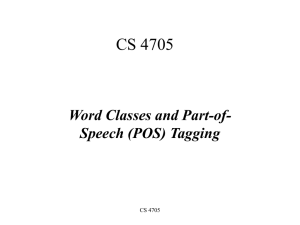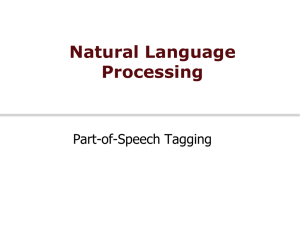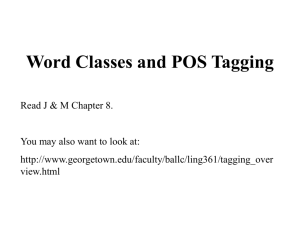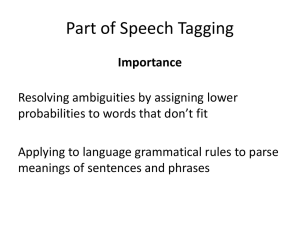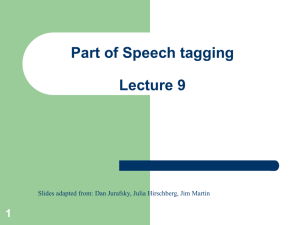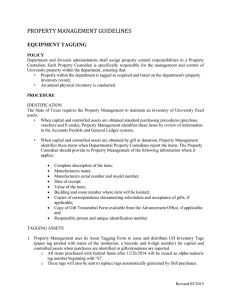Word Classes and Part-of-Speech (POS) Tagging CS4705 Julia Hirschberg
advertisement
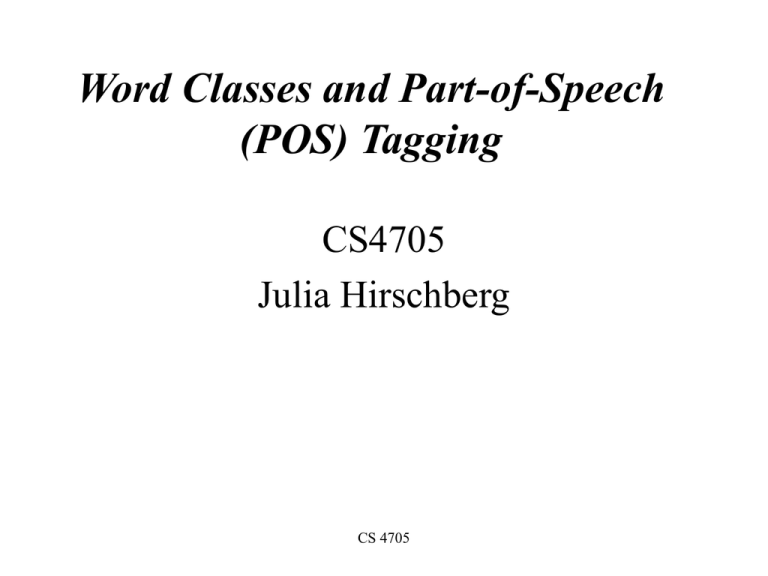
Word Classes and Part-of-Speech (POS) Tagging CS4705 Julia Hirschberg CS 4705 Garden Path Sentences • The old dog …………the footsteps of the young. • The cotton clothing …………is made of grows in Mississippi. • The horse raced past the barn …………fell. 2 Word Classes • Words that somehow ‘behave’ alike: – Appear in similar contexts – Perform similar functions in sentences – Undergo similar transformations • ~9 traditional word classes of parts of speech – Noun, verb, adjective, preposition, adverb, article, interjection, pronoun, conjunction 3 Some Examples • • • • • • • N V ADJ ADV P PRO DET noun verb adjective adverb preposition pronoun determiner chair, bandwidth, pacing study, debate, munch purple, tall, ridiculous unfortunately, slowly of, by, to I, me, mine the, a, that, those 4 Defining POS Tagging • The process of assigning a part-of-speech or lexical class marker to each word in a corpus: WORDS the koala put the keys on the table TAGS N V P DET 5 Applications for POS Tagging • Speech synthesis pronunciation – – – – – – Lead INsult OBject OVERflow DIScount CONtent Lead inSULT obJECT overFLOW disCOUNT conTENT • Parsing: e.g. Time flies like an arrow – Is flies an N or V? • Word prediction in speech recognition – Possessive pronouns (my, your, her) are likely to be followed by nouns – Personal pronouns (I, you, he) are likely to be followed by verbs • Machine Translation 6 Closed vs. Open Class Words • Closed class: relatively fixed set – – – – Prepositions: of, in, by, … Auxiliaries: may, can, will, had, been, … Pronouns: I, you, she, mine, his, them, … Usually function words (short common words which play a role in grammar) • Open class: productive – English has 4: Nouns, Verbs, Adjectives, Adverbs – Many languages have all 4, but not all! – In Lakhota and possibly Chinese, what English treats as adjectives act more like verbs. 7 Open Class Words • Nouns – Proper nouns • Columbia University, New York City, Arthi Ramachandran, Metropolitan Transit Center • English capitalizes these • Many have abbreviations – Common nouns • All the rest • German capitalizes these. 8 – Count nouns vs. mass nouns • Count: Have plurals, countable: goat/goats, one goat, two goats • Mass: Not countable (fish, salt, communism) (?two fishes) • Adjectives: identify properties or qualities of nouns – Color, size, age, … – Adjective ordering restrictions in English: • Old blue book, not Blue old book – In Korean, adjectives are realized as verbs • Adverbs: also modify things (verbs, adjectives, adverbs) – The very happy man walked home extremely slowly yesterday. 9 – – – – Directional/locative adverbs (here, home, downhill) Degree adverbs (extremely, very, somewhat) Manner adverbs (slowly, slinkily, delicately) Temporal adverbs (Monday, tomorrow) • Verbs: – In English, take morphological affixes (eat/eats/eaten) – Represent actions (walk, ate), processes (provide, see), and states (be, seem) – Many subclasses, e.g. • eats/V eat/VB, eat/VBP, eats/VBZ, ate/VBD, eaten/VBN, eating/VBG, ... • Reflect morphological form & syntactic function How Do We Assign Words to Open or Closed? • Nouns denote people, places and things and can be preceded by articles? But… My typing is very bad. *The Mary loves John. • Verbs are used to refer to actions, processes, states – But some are closed class and some are open I will have emailed everyone by noon. • Adverbs modify actions – Is Monday a temporal adverbial or a noun? 11 Closed Class Words • Idiosyncratic • Closed class words (Prep, Det, Pron, Conj, Aux, Part, Num) are generally easy to process, since we can enumerate them….but – Is it a Particles or a Preposition? • George eats up his dinner/George eats his dinner up. • George eats up the street/*George eats the street up. – Articles come in 2 flavors: definite (the) and indefinite (a, an) • What is this in ‘this guy…’? 12 Choosing a POS Tagset • To do POS tagging, first need to choose a set of tags • Could pick very coarse (small) tagsets – N, V, Adj, Adv. • More commonly used: Brown Corpus (Francis & Kucera ‘82), 1M words, 87 tags – more informative but more difficult to tag • Most commonly used: Penn Treebank: handannotated corpus of Wall Street Journal, 1M words, 45-46 subset – We’ll use for HW1 13 Penn Treebank Tagset 14 Using the Penn Treebank Tags • The/DT grand/JJ jury/NN commmented/VBD on/IN a/DT number/NN of/IN other/JJ topics/NNS ./. • Prepositions and subordinating conjunctions marked IN (“although/IN I/PRP..”) • Except the preposition/complementizer “to” is just marked “TO” • NB: PRP$ (possessive pronoun) vs. $ 15 Tag Ambiguity • Words often have more than one POS: back – The back door = JJ – On my back = NN – Win the voters back = RB – Promised to back the bill = VB • The POS tagging problem is to determine the POS tag for a particular instance of a word 16 Tagging Whole Sentences with POS is Hard • Ambiguous POS contexts – E.g., Time flies like an arrow. • Possible POS assignments – Time/[V,N] flies/[V,N] like/[V,Prep] an/Det arrow/N – Time/N flies/V like/Prep an/Det arrow/N – Time/V flies/N like/Prep an/Det arrow/N – Time/N flies/N like/V an/Det arrow/N – ….. 17 How Big is this Ambiguity Problem? 18 How Do We Disambiguate POS? • Many words have only one POS tag (e.g. is, Mary, very, smallest) • Others have a single most likely tag (e.g. a, dog) • Tags also tend to co-occur regularly with other tags (e.g. Det, N) • In addition to conditional probabilities of words P(w1|wn-1), we can look at POS likelihoods (P(t1|tn1)) to disambiguate sentences and to assess sentence likelihoods 19 Some Ways to do POS Tagging • Rule-based tagging – E.g. EnCG ENGTWOL tagger • Transformation-based tagging – Learned rules (statistic and linguistic) – E.g., Brill tagger • Stochastic, or, Probabilistic tagging – HMM (Hidden Markov Model) tagging 20 Rule-Based Tagging • Typically…start with a dictionary of words and possible tags • Assign all possible tags to words using the dictionary • Write rules by hand to selectively remove tags • Stop when each word has exactly one (presumably correct) tag 21 Start with a POS Dictionary • • • • • • • she: PRP promised: VBN,VBD to: TO back: VB, JJ, RB, NN the: DT bill: NN, VB Etc… for the ~100,000 words of English 22 Assign All Possible POS to Each Word VBN PRP VBD She promised TO to NN RB JJ VB back DT the VB NN bill 23 Apply Rules Eliminating Some POS E.g., Eliminate VBN if VBD is an option when VBN|VBD follows “<start> PRP” NN RB VBN JJ VB PRP VBD TO VB DT NN She promised to back the bill 24 Apply Rules Eliminating Some POS E.g., Eliminate VBN if VBD is an option when VBN|VBD follows “<start> PRP” NN RB JJ VB PRP VBD TO VB DT NN She promised to back the bill 25 EngCG ENGTWOL Tagger • Richer dictionary includes morphological and syntactic features (e.g. subcategorization frames) as well as possible POS • Uses two-level morphological analysis on input and returns all possible POS • Apply negative constraints (> 3744) to rule out incorrect POS Sample ENGTWOL Dictionary 27 ENGTWOL Tagging: Stage 1 • First Stage: Run words through FST morphological analyzer to get POS info from morph • E.g.: Pavlov had shown that salivation … Pavlov PAVLOV N NOM SG PROPER had HAVE V PAST VFIN SVO HAVE PCP2 SVO shown SHOW PCP2 SVOO SVO SV that ADV PRON DEM SG DET CENTRAL DEM SG CS salivation N NOM SG 28 ENGTWOL Tagging: Stage 2 • Second Stage: Apply NEGATIVE constraints • E.g., Adverbial that rule – Eliminate all readings of that except the one in It isn’t that odd. Given input: that If (+1 A/ADV/QUANT) ; if next word is adj/adv/quantifier (+2 SENT-LIM) ; followed by E-O-S (NOT -1 SVOC/A) ; and the previous word is not a verb like consider which allows adjective complements (e.g. I consider that odd) Then eliminate non-ADV tags Else eliminate ADV 29 Transformation-Based (Brill) Tagging • Combines Rule-based and Stochastic Tagging – Like rule-based because rules are used to specify tags in a certain environment – Like stochastic approach because we use a tagged corpus to find the best performing rules • Rules are learned from data • Input: – Tagged corpus – Dictionary (with most frequent tags) 7/15/2016 30 Transformation-Based Tagging • Basic Idea: Strip tags from tagged corpus and try to learn them by rule application – For untagged, first initialize with most probable tag for each word – Change tags according to best rewrite rule, e.g. “if word-1 is a determiner and word is a verb then change the tag to noun” – Compare to gold standard – Iterate • Rules created via rule templates, e.g.of the form if word-1 is an X and word is a Y then change the tag to Z” – Find rule that applies correctly to most tags and apply – Iterate on newly tagged corpus until threshold reached – Return ordered set of rules • NB: Rules may make errors that are corrected by later rules 7/15/2016 31 Templates for TBL 7/15/2016 32 Sample TBL Rule Application • Labels every word with its most-likely tag – E.g. race occurences in the Brown corpus: • P(NN|race) = .98 • P(VB|race)= .02 • is/VBZ expected/VBN to/TO race/NN tomorrow/NN • Then TBL applies the following rule – “Change NN to VB when previous tag is TO” … is/VBZ expected/VBN to/TO race/NN tomorrow/NN becomes … is/VBZ expected/VBN to/TO race/VB tomorrow/NN 7/15/2016 33 TBL Tagging Algorithm • Step 1: Label every word with most likely tag (from dictionary) • Step 2: Check every possible transformation & select one which most improves tag accuracy (cf Gold) • Step 3: Re-tag corpus applying this rule, and add rule to end of rule set • Repeat 2-3 until some stopping criterion is reached, e.g., X% correct with respect to training corpus • RESULT: Ordered set of transformation rules to use on new data tagged only with most likely POS tags 7/15/2016 35 TBL Issues • Problem: Could keep applying (new) transformations ad infinitum • Problem: Rules are learned in ordered sequence • Problem: Rules may interact • But: Rules are compact and can be inspected by humans 7/15/2016 36 Evaluating Tagging Approaches • For any NLP problem, we need to know how to evaluate our solutions • Possible Gold Standards -- ceiling: – Annotated naturally occurring corpus – Human task performance (96-7%) • How well do humans agree? • Kappa statistic: avg pairwise agreement corrected for chance agreement – Can be hard to obtain for some tasks: sometimes humans don’t agree • Baseline: how well does simple method do? – For tagging, most common tag for each word (91%) – How much improvement do we get over baseline? Methodology: Error Analysis • Confusion matrix: – E.g. which tags did we most often confuse with which other tags? – How much of the overall error does each confusion account for? VB VB TO NN TO NN More Complex Issues • Tag indeterminacy: when ‘truth’ isn’t clear Caribbean cooking, child seat • Tagging multipart words wouldn’t --> would/MD n’t/RB • How to handle unknown words – Assume all tags equally likely – Assume same tag distribution as all other singletons in corpus – Use morphology, word length,…. Summary • We can develop statistical methods for identifying the POS of word sequences which come close to human performance – high 90s • But not completely “solved” despite published statistics – Especially for spontaneous speech • Next Class: Read Chapter 6:1-5 on Hidden Markov Models
